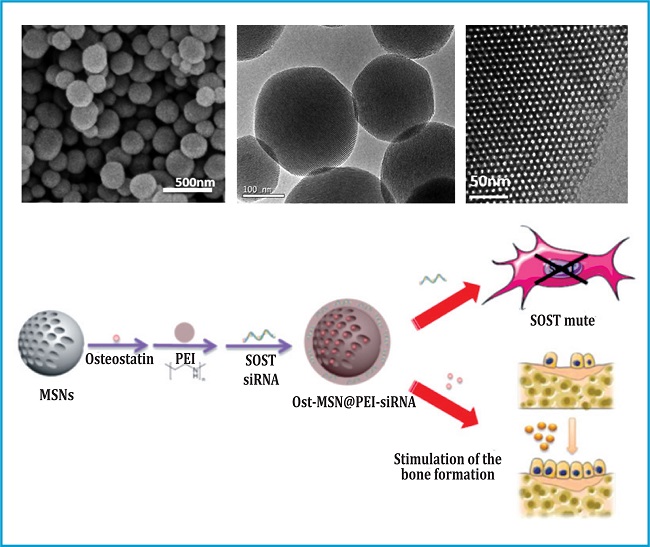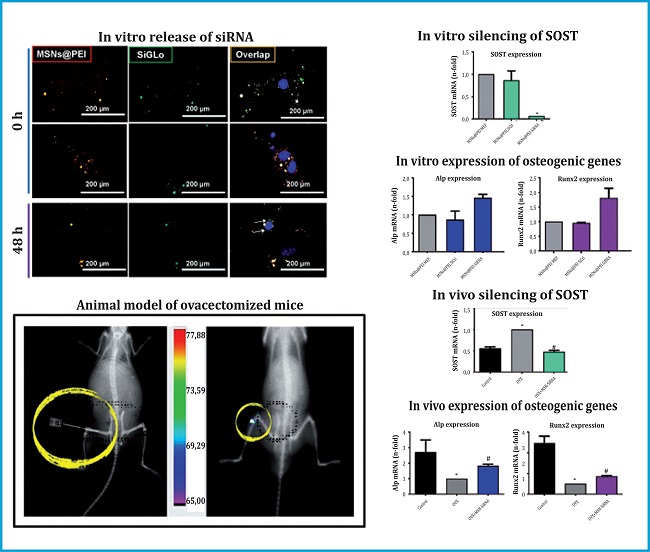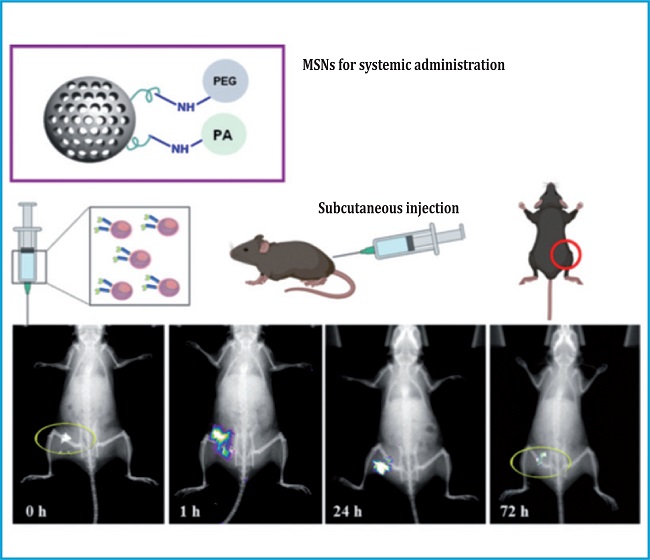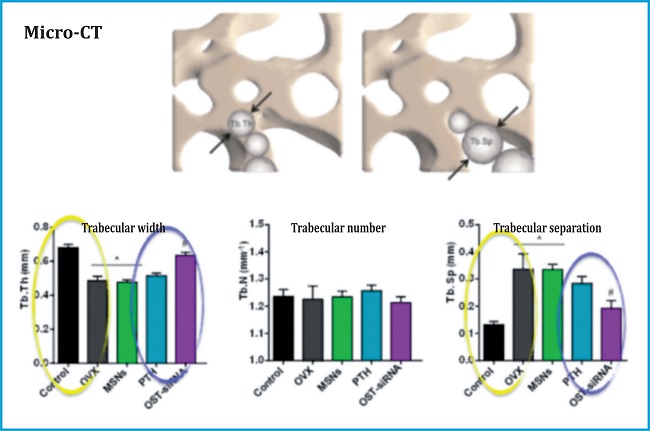Mi SciELO
Servicios Personalizados
Revista
Articulo
Indicadores
-
 Citado por SciELO
Citado por SciELO -
 Accesos
Accesos
Links relacionados
-
 Citado por Google
Citado por Google -
 Similares en
SciELO
Similares en
SciELO -
 Similares en Google
Similares en Google
Compartir
Revista de Osteoporosis y Metabolismo Mineral
versión On-line ISSN 2173-2345versión impresa ISSN 1889-836X
Rev Osteoporos Metab Miner vol.14 no.4 Madrid oct./dic. 2022 Epub 27-Mar-2023
https://dx.doi.org/10.4321/s1889-836x2022000400001
EDITORIAL
Mesoporous silica nanoparticles and osteoporosis
1Pharmacy Faculty. Complutense University of Madrid. Health Research Institute, Hospital 12 de Octubre i+12. Madrid (Spain)
2Biomedical Research on Bioengineering, Biomaterials and Nanomedicine Network Center (CIBER-BBN). Madrid (Spain)
NANOMEDICINE
The application of nanotechnology in medicine has given rise to a new discipline: nanomedicine, which, as we can imagine, is a multidisciplinary field where many main actors take part: engineers, physicists, chemists, biologists, doctors and even legislators1. Nanomedicines are so popular today among the scientific community due to a series of factors, among which we would highlight the control over the pharmacokinetic profile, the protection of transported therapeutic agents against possible degradation within the organism, the possibility of developing targeted therapies towards specific tissues, the possibility of including different therapeutic agents in the same transporter and even the possible inclusion of contrast agents to have a biomedical image for diagnosis. In this sense, among the possible systems of drug release, nanoparticles have acquired great prominence since they present great versatility from the point of view of their composition, shape, size, and external surface2.
This makes them the focus of a large number of biomedical researches for either the treatment of certain diseases, their prevention, diagnosis, or even in tissue engineering.
MESOPOROUS SILICA NANOPARTICLES
Among all the nanoparticles used in the field of nanomedicine, whether organic or inorganic, mesoporous silica nanoparticles (MSNs) are being widely studied in recent years as transport vectors for therapeutic agents3.
Their notoriety could be attributed their robustness, their porous system’s very high load capacity, their ability to protect drugs against possible degradation and the ease with which their outer surface can be modified4. The synthesis of these nanoparticles is based on the combination of 3 methods: the sol-gel process, in which the hydrolysis and condensation of the silica precursors that will form the three-dimensional web of SiO2 takes place; the use of surfactants as directing agents of the structure as templates, so that the silica condenses around the structures created by these surfactants which, after their elimination, will prompt a network of cavities or mesoporous structures; and the use of high dilution conditions, as proposed by the Stöber method, which allows to obtain spherical shaped nanoparticles of very defined diameters, between 100 and 150 nm, and with pores of around 2 nm, available to be loaded with therapeutic agents. In this sense, the concept of introducing drugs inside the pores of mesoporous materials to later be released into the organism was first proposed by Professor María Vallet-Regí in 2001. This has inspired considerable research conducted by different groups around the world5. In this sense, our research group has worked hard in recent years to develop MSNs capable of accumulating in different tissues in a specific way and releasing loaded drugs in response to different stimuli6 (figure 1).
TREATMENT OF OSTEOPOROTIC SITUATIONS
Among all the possible applications, an interesting example in which we have worked on in recent years is the use of mesoporous silica nanoparticles for the possible treatment of osteoporosis7,8.
In an osteoporotic setting, the WNT/β-catenin signaling pathway, which normally participates in the differentiation of mesenchymal stem cells to osteoblasts, is inhibited. This happens due to the overexpression of the sclerostin protein, which is encoded by the SOST gene. The consequence of this inhibition is the reduction of osteoblastic differentiation and, as a consequence, the reduction of bone formation and loss of bone mass so characteristic in osteoporosis. Our working hypothesis has been based on the possibility of silencing the SOST gene using a small interfering RNA (siRNA), in order to reduce sclerostin expression and to be able to reactivate the WNT/β-catenin cycle, and thus reactivate osteoblastic differentiation and consequently increase bone formation, so important in osteoporotic scenarios. However, siRNAs have very short life spans and very poor ability to penetrate cell membranes, so their biggest problem is their administration, and that is where our nanoparticles acquired great relevance. We coated our MSNs with a cationic polymer capable of retaining the siRNA on their surface to be later released, silencing the SOST gene and causing increased bone formation.
After optimizing the system in terms of siRNA design and loading, we found that our nanoparticles were capable, not only, of releasing siRNA inside cells, but also of reducing SOST expression in vitro and increasing other osteogenic factors’ SOST expression, such as alkaline phosphatase (ALP) and RUNx2 (figure 2).
We also had very positive results by injecting our nanoparticles into the bone marrow of the femur in osteoporotic female mice, observing the reduction in the expression of the SOST gene and the consequent increase in the expression of certain osteogenic genes.
Taking into account the difficulty of an administration by injection into the bone marrow of the femur could entail in a future clinical application, we decided to redesign the system. To do so, MSNs with high affinity for bone tissue were developed by anchoring bisphosphonates on their surface, which are molecules with a high affinity for the inorganic content of bone, in order to administer them by subcutaneous injection, a much easier method, so the nanoparticles themselves preferentially accumulate in bone tissue. In fact, we observed that after 72 hours of injection, the nanoparticles were still in the area (figure 3).
After different treatments lasting 2 to 3 weeks with successive subcutaneous injections every 72 hours, real-time PCR analysis of the different gene expressions in the bone tissue of osteoporotic animals revealed that we were able, not only of silencing the gene SOST, but also of increasing the expression of various osteogenic genes, such as Runx2, Alp, Osterix and Osteoprotegerin, as well as increasing vascular endothelial growth factor (VEGF), which relates to an increase in vascularization, all this factors pointing at the formation of new bone tissue (figure 4).
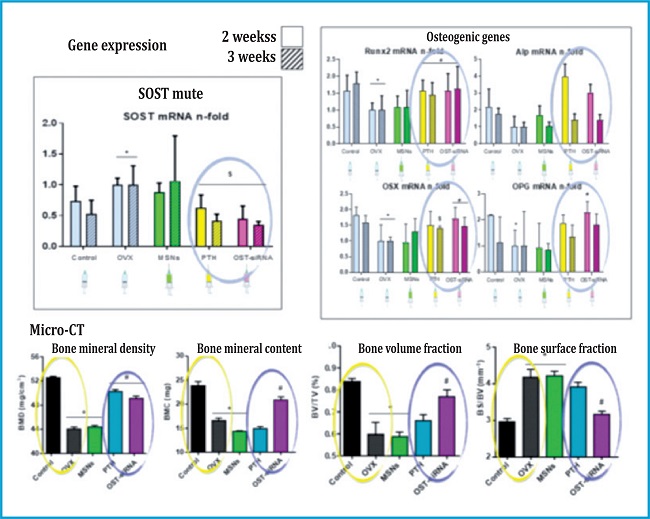
Top: Gene expression results in vivo after administration of the nanoparticles. Bottom: in vivo micro‐CT results after administration of the nanoparticles.
Figure 4.
In line with the results obtained, the microcomputed tomography analysis revealed significant increases in bone mineral density and bone mineral content, which, together with the quality of the new bone formed, similar to healthy bone as revealed by trabecular thickness and trabecular separation, gave us significant results in terms of new bone formation and quality in an in vivo model of osteoporotic female mice (figure 5).
This way, this brilliant investigation showed the skills of mesoporous silica nanoparticles in a possible treatment of osteoporosis, proving their capacity to load, transport, protect and intracellularly release a particular type of nucleic acid: a siRNA to silence a specific gene responsible for a malfunction in bone tissue development. These results open the doors for this type of MSNs to be used for carrying a large number of nucleic acids, including all types of RNAs or DNAs, with a wide variety of final applications within the biomedicine of the future.
Acknowledgments:
The authors thank Dr. Patricia Mora-Raimundo for her work in this area. Her thesis was based on this type of application of mesoporous silica nanoparticles.
REFERENCES
1 T. Lammers, M. Ferrari. The success of nanomedicine. Nano Today, 2020, 31, 100853. https://doi.org/10.1016/j.nan-tod.2020.100853. [ Links ]
2 M.J. Mitchell, M.M. Billingsley, R.M. Haley M.E. Wechsler, N.A. Peppas, R. Langer. Engineering precision nanoparticles for drug delivery. Nat. Rev. Drug Discov., 2021,20,101-124. https://doi.org/10.1038/s41573-020-0090-8. [ Links ]
3 M. Vallet-Regí, F. Schüth, D. Lozano, M. Colilla, M. Manzano. Engineering meso-porous silica nanoparticles for drug delivery: where are we after two decades?, Chem. Soc. Rev., 2022,51,5365-5451. http://dx.doi.org/10.1039/D1CS00659 [ Links ]
4 M. Manzano, M. Vallet-Regí. Mesoporous Silica Nanoparticles for Drug Delivery. Adv. Funct. Mater., 2020, 30,1902634. https://doi.org/10.1002/adfm.201902634. [ Links ]
5 M. Vallet-Regi, A. Rámila, R. P. del Real, J. Pérez-Pariente. A New Property of MCM-41: Drug Delivery System. Chem. Mater., 2001,13,308-311. https://doi.org/10.1021/cm001155. [ Links ]
6 M. Vallet-Regí. Our contributions to applications of mesoporous silica nanoparticles. Acta Biomaterialia, 2022, 137, 44-52. https://doi.org/10.1016/j.act-bio.2021.10.011. [ Links ]
7 P. Mora-Raimundo, D. Lozano, M. Manzano, M. Vallet-Regí. Nanoparticles to Knockdown Osteoporosis-Related Gene and Promote Osteogenic Marker Expression for Osteoporosis Treatment. ACS Nano, 2019,13,5451-5464. https://doi.org/10.1021/acsnano.9b00241. [ Links ]
8 P Mora-Raimundo, D. Lozano, M. Benito, F. Mulero, M. Manzano, M. Vallet-Regí. Osteoporosis Remission and New Bone Formation with Mesoporous Silica Na-noparticles. Adv. Sci., 2021,8,2101107. https://doi.org/10.1002/advs.202101107. [ Links ]











 texto en
texto en 

